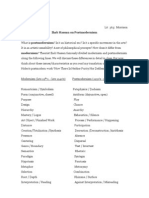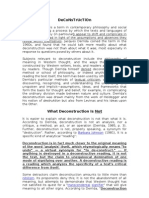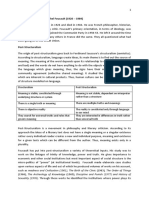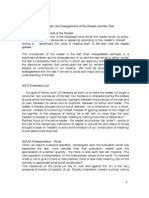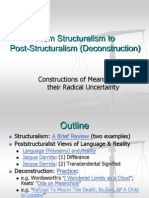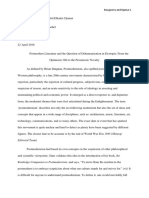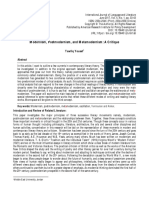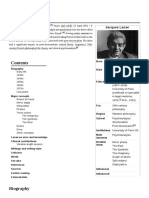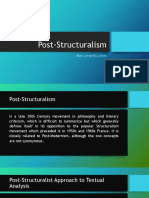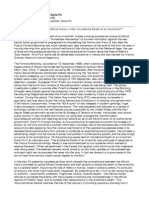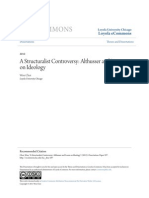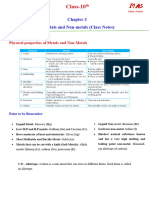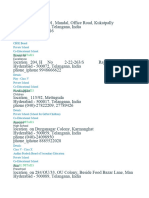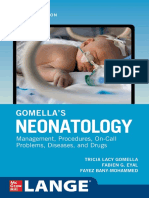0 ratings0% found this document useful (0 votes)
116 viewsPostmodernism: 1.1. Background
Postmodernism: 1.1. Background
Uploaded by
Marie StoieThe document discusses postmodernism and its relationship to literature and novels. Some key points:
- Postmodernism implies a reaction against modernism and questions beliefs of modernity like objective truth or a common human experience.
- In literature, postmodernism is seen in novels that preach a return to history and narrative, are self-reflective (metafictional), and blur the lines between fiction and non-fiction.
- Postmodern novels also incorporate multiple perspectives, use irony and intertextuality, and highlight the artificial construction of history in texts.
Copyright:
© All Rights Reserved
Available Formats
Download as PDF, TXT or read online from Scribd
Postmodernism: 1.1. Background
Postmodernism: 1.1. Background
Uploaded by
Marie Stoie0 ratings0% found this document useful (0 votes)
116 views9 pagesThe document discusses postmodernism and its relationship to literature and novels. Some key points:
- Postmodernism implies a reaction against modernism and questions beliefs of modernity like objective truth or a common human experience.
- In literature, postmodernism is seen in novels that preach a return to history and narrative, are self-reflective (metafictional), and blur the lines between fiction and non-fiction.
- Postmodern novels also incorporate multiple perspectives, use irony and intertextuality, and highlight the artificial construction of history in texts.
Original Description:
Postmodernism University Reader
Original Title
Postmodernism
Copyright
© © All Rights Reserved
Available Formats
PDF, TXT or read online from Scribd
Share this document
Did you find this document useful?
Is this content inappropriate?
The document discusses postmodernism and its relationship to literature and novels. Some key points:
- Postmodernism implies a reaction against modernism and questions beliefs of modernity like objective truth or a common human experience.
- In literature, postmodernism is seen in novels that preach a return to history and narrative, are self-reflective (metafictional), and blur the lines between fiction and non-fiction.
- Postmodern novels also incorporate multiple perspectives, use irony and intertextuality, and highlight the artificial construction of history in texts.
Copyright:
© All Rights Reserved
Available Formats
Download as PDF, TXT or read online from Scribd
Download as pdf or txt
0 ratings0% found this document useful (0 votes)
116 views9 pagesPostmodernism: 1.1. Background
Postmodernism: 1.1. Background
Uploaded by
Marie StoieThe document discusses postmodernism and its relationship to literature and novels. Some key points:
- Postmodernism implies a reaction against modernism and questions beliefs of modernity like objective truth or a common human experience.
- In literature, postmodernism is seen in novels that preach a return to history and narrative, are self-reflective (metafictional), and blur the lines between fiction and non-fiction.
- Postmodern novels also incorporate multiple perspectives, use irony and intertextuality, and highlight the artificial construction of history in texts.
Copyright:
© All Rights Reserved
Available Formats
Download as PDF, TXT or read online from Scribd
Download as pdf or txt
You are on page 1of 9
At a glance
Powered by AI
The passage discusses postmodernism and its relationship to modernism, literature, and some of its key features and assumptions. It also discusses women's writing, postcolonial voices, and issues in late 20th century fiction and postcolonial literature.
Some of the features of postmodernist texts mentioned are the return to history, return to narrative, result of self-contemplation, and bringing forth the fiction/fact paradox.
One of the dominant issues addressed in late 20th century fiction according to the passage is the problem of constructing identity, which has been influenced by psychoanalytic writings.
POSTMODERNISM
Chapter 1 – Postmodernism
1.1. Background
The term ‘postmodernism’ has invaded the contemporary cultural
stage. It appears in a wide range of texts and contexts, carrying numerous
connotations. Its all-encompassing nature partly defines the multitude of
changes that our world has recently witnessed, and partly demands an elitist
interpreter to penetrate its deepest philosophy. Unless one is tempted into
using it as an umbrella term for everything that makes today a unique and
challenging mixture of clashing worlds and perspectives (from fashion and
advertising to visual arts and literary theory) it has to be looked upon as a
term in the making, as expressing a break, a fissure in the flow of tradition in
all domains.
If anything, postmodernism implies a reaction against modernism.
Some of the basic beliefs of modernity are turned upside down and inside out
by the ways in which we now choose to describe the world. More importantly,
the aesthetics of modernism is discarded as false, pretentious, much too
experimental to match our desperate attempts at penetrating beyond
surfaces and anchoring our whole existence in something worthwhile.
Seismic transformations have taken place and we are confronted with
cultural events derived from previously unheard of phenomena: new viruses
(including electronic ones) resisting antidote, cloning, widespread genocide,
travels into space, portable communication facilitators – to name only a few.
Consequently, if we accept to describe our age in terms of postmodernism,
we are forced to take into account the multifarious aspects it presupposes
and deal with it as complex, involving a multidisciplinary effort.
From among them, the most noteworthy (involved in a mutual
relationship with the literary stage) seem to be:
globalisation
identity politics
economy of reproduction
media capitalism
computer hyperreality
fragmentation
high technology
life imitating art
Nevertheless, despite its diverse and eclectic nature, postmodernism
can be recognized by two key assumptions: […] that there is no common
denominator – in ‘nature’ or ‘truth’ or ‘God’ or ‘the future’ – that guarantees
either the One-ness of the world or the possibility of neutral or objective
thought [and] that all human systems operate like language, being self-
reflexive rather than referential systems – systems of differential function
which are powerful but finite, and which construct and maintain meaning and
value. (Edward Craig [ed], Routledge Encyclopedia of Philosophy, 1998:
587)
POSTMODERNISM AND THE NOVEL IN ENGLISH 7
ON MODERNISM
POSTMODERNISM
Literature, as already implied, is the perfect common ground for the
marriage of opposites and the interplay of diverse positions. In its obvious
enterprise of building worlds (other than, parallel to, but similar to ours), it
allows for the freedom of choice, opinion and imagination. Using words to
represent worlds, it denies THE referent, THE signified, questioning unity and
directing the text/signifier towards a liberating plurality. Literature itself has
become yet another manifestation of the world as text, of that which we now
accept as the ‘textuality’ of the contingent, whose ‘texting’ (reading, rereading
and misreading) is a universal practice, a globalising factor therefore.
In literature, the novel especially, postmodernism may be said to be
recognisable at the level of that particular text which has any, some or all of
the following features inscribed into it:
preaches in favour of the return to history (previously having been fought
back by the modernist writing – in flight from chronology, from objectively
representing that which lies beyond it and which interferes with one’s private,
intimate experiences)
illustrates the obvious return to narrative (taken apart by earlier twentieth
century writers, seemingly interested in mirroring the chaotic state of things in
the world outside at the level of the literary work by abolishing clear structure,
neat plot)
is mainly the result of self-contemplation (rounding itself up as
metafictional – exposing its inner workings, deconspiring its purposes and
addressing a reader accustomed to working with and reading into literariness)
brings forth the fiction/fact paradox (by allowing its ‘consumer’ to
understand that the only reality it observes is that of the very textuality of the
text, of the materiality of the pages which, once written, become part of the
contingent and potentially inspire others)
enters the post-symbolist phase (not abandoning the symbol, but using it
in its broader acceptance, that of archetype; rather than manipulating private
symbols to show the interaction between feeling and thought, public ones are
formed by endowing the former with archetypal significance)
shapes itself up as parody or oblique criticism (in an attempt at embedding
tradition while, at the same time, disclosing the absurd, false anachronism at
its core; simultaneously makes the text easily digestible, entertaining and
instructs its audiences)
incorporates critical perspectives (somehow implying that there is no such
thing as a clearly delineated frontier between the literary and the literary
critical – a trespassing that points to the melting of fiction into non-fiction and
vice versa)
presupposes an academic novelist (usually a professor of literary studies,
whose teaching expertise is used both as a starting point, therefore
autobiographically, and as an end, so as to find a cure for the common illness
of anxiety with/due to the ‘difficult-to-define-and-follow’ literature)
blurs the history/fiction border (by looking into the subjectivity
characterising all texts, historical ones included, and by subtly underlining the
idea that history cannot be taken for fact or reality, but only for yet another
version of his-story)
sends to the textuality of history (nourishing the comforting thought that
one can easily intervene in the texts already written, and can rewrite history,
if not backwards, at least from a totally different perspective: that of a
continuous present)
POSTMODERNISM AND THE NOVEL IN ENGLISH 8
ON MODERNISM
POSTMODERNISM
includes highlighted artifice (foregrounding and emphasizing the other,
novel, shocking – with a view to awakening readers from a culturally induced
complacency with accepting the traditional and postponing the innovative in
all walks of life)
makes extensive use of irony (structural or verbal, achieved by the
handling of multiple/possible viewpoints about its subject matter or,
respectively, by understatement, concealment and allusion; turns the text into
a complex, fascinating whole)
is governed by intertextuality (a thorough reader above everything else,
the postmodernist writer – aware of the fact that there is little left
unsaid/unwritten, that the world itself is a text –turns to the enormous library
that precedes him)
reformulates magic realism (mixing and disrupting ordinary, commonplace
realism with strange, miraculous episodes and powers; adding a fantastic
dimension to the engagement with political and social issues)
is forwarded in keeping with the principles of fabulation (self-consciously
includes fictions within fiction and catches the reader in the trap of elaborate
forms and misleading paths that do not match his/her expectations)
constructs a surrogate reader/author (includes a reader or an author as
characters within the narrative so as to de-canonise them and to endow them
with a voice by means of which artistic credos are formulated and opinions
supported)
All the enumerated features might help to establish some sort of order,
some backbone of the contemporary textual scene – a scene of dissolution, a
vertiginous melting-pot where the old canons of ‘literature’ are invaded by
textual stuff from psychology, philosophy, law, medicine, geography, and the
old generic boundaries are down, and the distinction between ‘literary’ and
‘non-literary’ goes, and old minor or marginal texts (authors’ jottings, essays,
fragments, versions, foul papers, say) cease to lurk in the supplementary
shadows and come busily in from the margin and the cold to receive equal
treatment with what were once thought of as the main objects of concern, the
poems and novels and plays, the published stuff, the final versions, and so
on. (Valentine Cunningham, In the Reading Gaol. Postmodernity, Texts
and History, 1994: 6)
They announce the non-conformism of today’s novel text and guide
along the path of counternarratives (see Henry Giroux et al. [eds],
Counternarratives. Cultural Studies and Pedagogies in Postmodern
Spaces, 1996), whose main functions seem to be:
disturbing grand narratives which gain legitimacy from foundational myths
concerning the origins and development of an unbroken history of the West
based on an evolutionary ideal of progress
opposing official narratives of everyday life propagated for specific political
purposes to manipulate public consciousness by heralding a national set of
common cultural ideals.
Numerous theorisers on the postmodern condition have affirmed that
postmodern counternarratives must, they themselves, be interrogated and
brought into productive dialogue with other narratives. It is only through
facilitating the clash that the discussion finds the appropriate grounds for
development.
Described as a method, a philosophy, an attitude, a tonality, a style, a
moment, a condition, a movement, a theory, postmodernism may therefore
be seen at work in the rewriting of the globally observable cultural crises and
POSTMODERNISM AND THE NOVEL IN ENGLISH 9
ON MODERNISM
POSTMODERNISM
in the formulation of trans-disciplinary literatures, most of which are self-
reflexive and self conscious, disclosing goals and inner patternings.
Its critique of the subject, of historicism and of philosophy (specificities
of the poststructuralist phase) has found favour not only with the practitioners
of metafiction, but also with feminist and postcolonial writers, seeking to show
how representation can no longer be considered a politically neutral and
theoretically innocent activity (Linda Hutcheon). Grouped under the umbrella
terms of ‘postmodernism of resistance’ or ‘postmodernism of reaction’, these
orientations bring to attention the plurality of language games so as to
advance an attack on the conceptions of universal reason, the unity of
language and the unified subject. Their politics of difference and of the local
and particular are not only symptoms of, but also essential strategies for
coping with a postmodernist culture that advertises itself as decentred,
transnational and pluralistic (Andrew Ross).
To conclude, the fashionable and elusive term (and notion) of
‘postmodernism’ has led to vigorous debates and bitter controversies.
Nevertheless, what emerges is the certainty that postmodernism is of great
interest because it directs our attention to the changes, the major
transformations, taking place in society and culture. Usually associated with it
are great names like: Warhol in art, Jencks in architecture, Artaud in drama,
Barth in fiction, Lynch in film, Sherman in photography, Derrida and Lyotard
and Baudrillard in philosophy. Of special interest to literary studies are the
works of the latter three, recommended titles being: Jacques Derrida’s The
End of the Book and the Beginning of Writing, Jean François Lyotard’s
The Postmodern Condition: A Report on Knowledge and Jean
Baudrillard’s Symbolic Exchange and Death.
1.2. Metafiction (Durrell, Fowles, Lodge)
Metafictional novels are the ones to explicitly reveal themselves as
fictional and to reflect on their own status and narrative procedures. Within
this self-reflective category, one can distinguish between:
overt, diegetic metafiction (that takes its status, the rules and
underlying conventions of the novel and the process of narration as its
theme)
covert, linguistic metafiction (that suggests, through language games,
intertextual references and parody, the inability of language to function
as a means of communication or, more importantly, its ability to create
worlds, alternative to and more meaningful than the ‘real’ one
underneath).
This bewildering type of novel, unlike the traditional realistic one, does
not want to maintain the illusion that what it is about is an objective reality,
which is truthfully reflected in language. It sooner aims at posing problems, at
teasing readers out of their acceptance of pre-established modes of thinking,
at inviting to play the literary game. Regarding the area that explores the
relationship between fiction and reality, the metafictional novel proposes a
number of startling questions:
Is there a reality ontologically separate and different from our linguistic
consciousness? And if there is, can we know it without altering it by our
knowledge? And if we can, can we ‘render’ it in language? And if we can,
does this rendering correspond to, give a truthful view of that ontologically
POSTMODERNISM AND THE NOVEL IN ENGLISH 10
ON MODERNISM
POSTMODERNISM
different reality that we have assumed to exist? Or are we fooling ourselves
in believing that there is such a reality, when in reality we are locked up in the
prison-house of language, in the reading gaol? (Guido Kums, Metafictional
Explorations into Novel Theory, in Marialuisa Bignami; Caroline Patey
(eds), Moving the Borders, 1996: 151)
Foregrounding the gap between art and life, metafiction occurs in the
form of asides (from prefaces and mottos to direct, authorially intrusive
passages) in novels that are primarily focused on traditional means of
conveying message, portraying characters and action; such passages are felt
as manipulative, employing the conventions of realism as they acknowledge
their artificiality; they address a reader that is supposed to know a lot about
the intricacies of weaving a text, flattering him by considering him an
intellectual equal who is aware of the fact that a work of fiction is a verbal
construction rather than a ‘slice of life’. As to metafictional writers, they seem
to have a sneaky habit of incorporating potential criticism into their text and
thus ‘fictionalize’ it (David Lodge, The Art of Fiction, 1992: 208).
The borders become additionally obscured due to the juxtaposition of
a number of possible worlds: the real, the fictitious, the fictionalised fictitious
and metafiction itself. The central issue remains that of TRUTH.
In literary studies, the distinction between fictional and factual
discourse ultimately depends on a correspondence conception of reference
and truth (the former with objects and facts), but such a conception is
untenable, pragmatist arguments in the philosophy of language supporting
the thesis by defining fiction through the inexistence of the objects it is
describing and thus including in its discourse false statements, deprived of
any truth.
The solutions offered envisage either admitting that the objects in
fiction have a certain type of existence, that can sometimes perfectly match
the existence of objects in the real world, or considering that the only objects
that exist are those of the real world, denying any existence to the objects in
fiction. Therefore, there is no ultimate ground for the distinction between
fictional and factual discourse:
Fiction is whatever is man-made (conceptually or linguistically).
Truth is man-made (conceptually or linguistically).
Therefore, truth is just a species of fiction.
(Peter Lamarque, Narrative and Invention, in Narrative in Culture, ed. by
Christopher Nash, 1994: 137).
If, linguistically speaking, the fictional discourse is a descriptive one, it
differs nonetheless from a referential type of discourse since its sequences
do not imply ‘real’ referents. But this is only a purely negative determination
of fiction – that simply shows what it does not do, without considering the
explanation of its positive function, one that replaces the act of reference with
‘real-ised’ objects.
From the logical point of view, fictional discourse is defined in terms of
the zero denotation: the linguistic constituents that, in factual discourse, have
a denotative function (proper names, deictics, demonstratives...) lack any
denotation proper. The fictional statement has a meaning, but no referent.
This definition of fiction as discourse with zero denotation has been accepted
by almost all logicians, but N. Goodman (1968) has brought to it an extra
dimension by insisting on the idea that it only sums up a necessary condition
(otherwise all types of false statements, lies included, would be ranked
among the fictional).
POSTMODERNISM AND THE NOVEL IN ENGLISH 11
ON MODERNISM
POSTMODERNISM
With metafiction therefore, non-denoted (but real-ised) is fiction itself.
The process of reaching that slippery referent is made difficult by the elitist
and self-parodic game of mirrors presupposed by the metafictional text, a
particular manifestation of intertext, allusive of other, similar texts, and
illustrative for literay text-forwarding. Considering itself and its artificiality, the
metatext may also be looked upon as intratext, whose depth is not simply
structural (usually numerous diegetic levels being juxtaposed), but message-
ridden also (the discussions on its own construction being turned into the
very content thus foregrounded).
Self-reflexive, self-aware and self-ironic, modern and contemporary
metafiction is anchored in Sterne’s Tristram Shandy and reaches far out to
texts yet unwritten, but whose existence will surely depend on precedents.
1.3. Feminist Issues (Lessing, Weldon)
In its various manifestations, literary feminism is a cultural politics
which aims at freeing itself from naturalised patriarchal notions. The
tremendous dynamism at work within feminist orientations has lead to the
formulation of numerous critiques and counter-critiques regarding both other
ideologies and its own positions, all of which start, however, from similar and
constantly innovative, challenging and subverting theories.
One speaks today of: British feminism, French feminism, Irish
feminism, American feminism, African feminism, Asian feminism, black
feminism, lesbian feminism, linguistic feminism, myth feminism,
psychoanalytic feminism, deconstructive feminism, gynesis, gynocritics etc. –
components of the same scene and usually at war with one another.
Historically speaking, the first feminist pronouncements in literary
studies were made in connection with the literary text as accentuating the
idea of androgyny (Virginia Woolf, Orlando). Later on, the emphasis was laid
on woman as ‘other’ and on the sex/gender opposition (Simone de Beauvoir,
The Second Sex).
The newer feminisms point out the differences between the sexes in
terms of biology, experience, discourse, the unconscious, politics, social and
economic realities. Works like Germaine Greer’s The Female Eunuch, Dale
Spender’s Man Made Language, Kate Millet’s Sexual Politics, Elaine
Showalter’s A Literature of their Own, Toril Moi’s Sexual/Textual Politics:
Feminist Literary Theory, Julia Kristeva’s Desire in Language, Hélène
Cixous’s The Laugh of the Medusa, Luce Irigaray’s The Sex Which Is Not
One are just a few of the many written during the last thirty years or so on the
issue of the female / feminine / feminist.
One interesting theory for the purpose of this course is formulated by
Elaine Showalter who, in an article published in 1979, Towards a Feminist
Poetics, distinguishes between two main types of feminist criticism:
feminist critique – which is concerned with woman-as-reader, with the
‘other’ consumer of male-produced literature, with the new light shed on the
text from her perspective
gynocritics – which is concerned with woman-as-writer, with the history,
themes, genre and structure of literature by women, with female language
and its referentiality
Both seek to foreground the newly visible world of female culture and
to find ways into the new language and new way of reading the transparent
medium of the text, integrating women’s intelligence, experience, reason and
POSTMODERNISM AND THE NOVEL IN ENGLISH 12
ON MODERNISM
POSTMODERNISM
suffering, scepticism and vision (see Elaine Showalter in Toril Moi,
Sexual/Textual Politics: Feminist Literary Theory, 2002)
The women novelists of the later half of the twentieth century, aware
of the contemporary preoccupation with feminist issues, address them either
directly (in an outspoken, politicised fashion) or obliquely (through parody
and language games). Their works are mostly about women, whose
problems can only be truly grasped by other women. They feature universes
which are built inside and against man’s world, and give a central voice to the
formerly silent fringes.
The most frequent aspects such novels bring to attention are:
representations of womanhood in texts written by men and women
the replacing of (his)story with her story
masculinity versus femininity with both sexes
the role of the social in the construction of man and woman as different
opposing woman-as-other by glimpses into man-as-other
fighting back patterns of authority, power, control, manipulation as
embodiments of patriarchy
rejecting the patriarchy of language and attempting to find a freer feminine
discourse to replace it
announcing the emancipation of man soon to take place and to allow for a
reconsideration of the ‘battle between the sexes’
Women writers, novelists and critics, have to be pluralists, given the
feminist insistence on the dominant and all-pervasive nature of patriarchal
power so far in history: there is no pure feminist or female space from which
we can speak (Toril Moi, Feminist Literary Criticism, in Ann Jefferson and
David Robey, Modern Literary Theory, 1988: 205). They need to find
appropriate means of showing just how much all ideas, including feminist
ones, have been contaminated by patriarchal ideology, without necessarily
criticising the inertia that has allowed the phenomenon to take place or the
impetus in its growing strong roots.
Women are shown engaging in routine activities, in living lives and
dreaming dreams. If caught in ridiculous or tragic hypostases, they seem to
deserve what is happening to them and their positions are made to raise
questions in the reader.
The individual characters, despite individual features, remain part of a
broader pattern, which is not so much due to biology as it is the result of
women historically having been subjected to the same kinds of oppression.
Under patriarchy, women have formed a separate subculture, and the thus
socially produced female essence is what feminist writing is mostly
concerned with.
The textual strategies by means of which anger is expressed are, from
the literary point of view, those which give feminist writing its savour. Inspired
from the literature of the past, but shaped to address a different kind of
readership, they speak about the many, but usually to the educated few who
might read stylistics into the politics of the text. From the immasculation of
discourse, to experimental narrative practices, the dissolution of obsolete
modes of analysing the self in fiction and fiction itself, the rearranging of
chronology and the metafictional commentary, texts by, about and for women
undermine the stable foundation of the canon, whose centrality has enforced
a marginal spot for women.
POSTMODERNISM AND THE NOVEL IN ENGLISH 13
ON MODERNISM
POSTMODERNISM
1.3. Postcolonial Voices (Rushdie, Ishiguro)
One of the dominant, obsessively recurrent issues of the late twentieth
century fiction – the problem of the subject, of constructing identity – has
probably been due to the tremendous influence that psychoanalytic writings
have had upon the contemporary mind and stage. Postmodern, hyperrealist,
magic realist and other experimental types of writing have primarily
concerned themselves with this problem reflected in fictional characterisation,
authorship and intentionality, readership, narrative technique, style, genre
and thematics.
Following psychoanalysis, the subject was portrayed in literature as
less stable and essentialist, and more in process, determined by the ‘other’.
As a result, gender, sexuality, ethnicity, class and race were split accordingly,
being shown as constructed out of difference, out of the dialogic, out of
discourse. Heterogeneity, not homogeneity or unitariness, impurity and
mélange, not originary purity, were shown to govern these aspects of identity.
The decentring and de-essentialising of the subject have brought about the
cultural story, the idea that meaning is provisional and social, and knowledge
always perspectival and contextual. Art, literature included, is no longer
considered as basically representational; it is sooner looked upon as
politicised and empowered, as participating (from the cultural point of view) in
the creation of the real. In it, signs replace objects of the material world. Its
power is symbolical.
Questioning representation remains, however, a subversive political
strategy, whose resistance to established practices and beliefs has managed
to place the emphasis on the margins rather than on the outmoded centre. In
terms of the imperialism of representation, fetishist images of the ‘margin’ are
produced from within ‘civilising’ centres to satisfy the western need for
political and psychological focal points and to silence any attempt at
autorepresentation with the former. In other words, if the margins have
become the centre, they have been denaturalised, forced to accept their very
condition of a margin – now fashionably at the core of universality.
Bringing the two together and alternating their role and significance,
postcolonial writing covers a wide range of ambivalent cultural modes and
formations, specific to the colonial aftermath – a period of transition and
translation in redefining old identities or discovering newly-acquired
oppositional ones.
Charged with the rhetoric of independence and the creative euphoria
of self-invention, postcolonial writing, in its earlier stages, has sought
therapeutic aid in the revisiting of the colonial past, offering itself to being
interpreted as committed to this complex project of historical and
psychological recovery.
In its present day form, postcolonialism in literature is oriented towards
the following problematics:
the economic, political and, more importantly, cultural heritage of the
colonial system
the classical debate on the equality of races, peoples, religions
the world and the book as authoritarian, ‘colonising’ structures
woman as ‘other’/colony/colonised
national politics versus nationalistic politics
POSTMODERNISM AND THE NOVEL IN ENGLISH 14
ON MODERNISM
POSTMODERNISM
the mutual transformations of globalisation, uniformisation and hybridity,
diaspora
textual politics and (post)colonial literatures
the metanarrative of the colonies, of colonialisation and of the end of
colonialism
Central remains the idea of history, synonymous in Western
philosophy with that of (European) civilisation, which has imposed itself as
ideal, supreme, dominant – a phenomenon obvious especially in the
international languages bringing along an intellectual, cultural, artistic, literary
colonialisation.
POSTMODERNISM AND THE NOVEL IN ENGLISH 15
ON MODERNISM
You might also like
- 3 Reasons Inception Is PostmodernistDocument3 pages3 Reasons Inception Is PostmodernistOdette BrownNo ratings yet
- Ihab Hassan On PostmodernismDocument2 pagesIhab Hassan On PostmodernismBeholdmyswarthyface0% (1)
- Structuralism SummaryDocument3 pagesStructuralism SummaryumamaNo ratings yet
- The Treatment of Time in Tristram ShandyDocument2 pagesThe Treatment of Time in Tristram ShandyMarie StoieNo ratings yet
- Chapter On PostmodernismDocument11 pagesChapter On PostmodernismAti SharmaNo ratings yet
- Post StructuralismDocument4 pagesPost StructuralismAly FahadNo ratings yet
- A Comparative Study of Liberal Humanism and StructuralismDocument1 pageA Comparative Study of Liberal Humanism and StructuralismConsumer LobbyNo ratings yet
- Yeats Symbolism of PoetryDocument1 pageYeats Symbolism of PoetryYudi UtomoNo ratings yet
- NaturalismDocument2 pagesNaturalismJimielyn MartinNo ratings yet
- Structuralism 1Document6 pagesStructuralism 1Ravneet Kour0% (1)
- DeconstructionDocument5 pagesDeconstructionBasheer AlraieNo ratings yet
- StructuralismDocument29 pagesStructuralismFarhat JabeenNo ratings yet
- Literary Theory and Schools of CriticismDocument30 pagesLiterary Theory and Schools of CriticismMaravilla JayNo ratings yet
- The Work of RepresentationDocument8 pagesThe Work of RepresentationRajPihu100% (1)
- The Origin OF Frankurt School: Calabuga & IdongDocument8 pagesThe Origin OF Frankurt School: Calabuga & IdongHiraiNo ratings yet
- Ferdinand de Saussure, From Course in General LinguisticsDocument10 pagesFerdinand de Saussure, From Course in General LinguisticsNahara RaduNo ratings yet
- Post Structuralism by Michel FoucaultDocument4 pagesPost Structuralism by Michel FoucaultTadh Tok CamdirNo ratings yet
- Irreversible Time and Entropy in Thomas Pynchon's The Crying of Lot 49 17Document17 pagesIrreversible Time and Entropy in Thomas Pynchon's The Crying of Lot 49 17alberto9correa-6No ratings yet
- Postmodern LiteratureDocument9 pagesPostmodern LiteraturejavedarifNo ratings yet
- Notes On Barthes SZDocument8 pagesNotes On Barthes SZRykalskiNo ratings yet
- Ferdinand de Saussure's Structural Linguistics Class NotesDocument15 pagesFerdinand de Saussure's Structural Linguistics Class NotesHilal YıldırımNo ratings yet
- PoststructuralismDocument45 pagesPoststructuralismMarc SiapnoNo ratings yet
- Style of Bertrand Russell: BiographyDocument9 pagesStyle of Bertrand Russell: BiographyAyeshaKhanKhattakNo ratings yet
- Postmodern Literature and The Question of Dehumanization in Dystopia: From The Optimistic Old To The Pessimistic NoveltyDocument14 pagesPostmodern Literature and The Question of Dehumanization in Dystopia: From The Optimistic Old To The Pessimistic Noveltychahinez bouguerra100% (1)
- Ion Is Plato's Only Dialogue Entirely Consecrated To The Theory of Literature. It Is Also The Oldest Extant Book On TheDocument4 pagesIon Is Plato's Only Dialogue Entirely Consecrated To The Theory of Literature. It Is Also The Oldest Extant Book On TheJennylyn AyagNo ratings yet
- Lyotard & Postmodernism (Theories & Methodologies Essay 2)Document12 pagesLyotard & Postmodernism (Theories & Methodologies Essay 2)David Jones100% (1)
- British Cultural MaterialismDocument22 pagesBritish Cultural Materialismsuzy994100% (1)
- Notes On Kant's What Is EnlightenmentDocument4 pagesNotes On Kant's What Is EnlightenmentTusha BhatiaNo ratings yet
- Foucault'S Ethics and PoliticsDocument30 pagesFoucault'S Ethics and PoliticsKubilay KaplanNo ratings yet
- PoststructuralismDocument8 pagesPoststructuralismbowman.webmail100% (1)
- Metamodernism, Modernism and Post ModernismDocument11 pagesMetamodernism, Modernism and Post ModernismWanderer InneverlandNo ratings yet
- Trends in Theoretical Approaches To Literary StudiesDocument42 pagesTrends in Theoretical Approaches To Literary StudiesJoshua100% (1)
- Postmodern LiteratureDocument14 pagesPostmodern Literatureapi-376795054100% (1)
- Lacan, Jacques - Insistence of The Letter in The Unconscious, (1966) 36-37 YFS 112Document36 pagesLacan, Jacques - Insistence of The Letter in The Unconscious, (1966) 36-37 YFS 112ignoramus83No ratings yet
- AssignmentDocument4 pagesAssignmentDivya KhasaNo ratings yet
- Quest For Identity PDFDocument12 pagesQuest For Identity PDFbe coolNo ratings yet
- Resumen The Schizoanalysis of LiteratureDocument27 pagesResumen The Schizoanalysis of LiteratureN IncaminatoNo ratings yet
- The Literary Phenomenon of Free Indirect Speech: Alina LESKIVDocument8 pagesThe Literary Phenomenon of Free Indirect Speech: Alina LESKIVcatcthetime26No ratings yet
- Modernism: "The Avantgarde" (Noun) : The Work of Painters, Writers, Musicians and Other ArtistsDocument4 pagesModernism: "The Avantgarde" (Noun) : The Work of Painters, Writers, Musicians and Other Artistsrok modNo ratings yet
- Jacques LacanDocument19 pagesJacques Lacanjovmac2u100% (1)
- Criticessay Marxism PrideprejudiceDocument4 pagesCriticessay Marxism Prideprejudiceapi-198081658No ratings yet
- Summary Mourning Becomes ElectraDocument9 pagesSummary Mourning Becomes ElectraDiana Rose BermilloNo ratings yet
- The Semiotic Review of Books: AllagmaticDocument12 pagesThe Semiotic Review of Books: AllagmaticGuilherme Moura FagundesNo ratings yet
- Begc 112 Eng 2024 (1) IgnouDocument18 pagesBegc 112 Eng 2024 (1) IgnouIGNOU ASSIGNMENT WALANo ratings yet
- Mrs. DallowayDocument5 pagesMrs. DallowayJorge SebastiánNo ratings yet
- Postmodern LiteratureDocument10 pagesPostmodern LiteraturemnazNo ratings yet
- The Concept of Reality From Postmodern PerspectivesDocument5 pagesThe Concept of Reality From Postmodern PerspectivesAnonymous Wfl201YbYoNo ratings yet
- Define Postmodern Media With ExamplesDocument4 pagesDefine Postmodern Media With ExamplesbeccawhitmoreNo ratings yet
- A Study of Socio-Political Manipulation in Bhisham Sahni's TamasDocument6 pagesA Study of Socio-Political Manipulation in Bhisham Sahni's TamasIJELS Research JournalNo ratings yet
- Literary Criticism ApproachDocument3 pagesLiterary Criticism ApproachDelfin Geo Patriarca100% (1)
- Annual Reviews Annual Review of Anthropology: This Content Downloaded From 92.241.95.11 On Sat, 12 Nov 2016 23:36:32 UTCDocument40 pagesAnnual Reviews Annual Review of Anthropology: This Content Downloaded From 92.241.95.11 On Sat, 12 Nov 2016 23:36:32 UTCWi-GoJeSeNo ratings yet
- Adorno I MimesisDocument13 pagesAdorno I MimesisbezimenostNo ratings yet
- Spiral of Silence TheoryDocument3 pagesSpiral of Silence TheoryHira RaufNo ratings yet
- Post-Structuralism: Mark Lester B. LamanDocument14 pagesPost-Structuralism: Mark Lester B. LamanMark Lester LamanNo ratings yet
- 5.1 Postmodern American AuthorsDocument44 pages5.1 Postmodern American AuthorsCosmina Catina MihailaNo ratings yet
- Subvert History EssayDocument4 pagesSubvert History Essayapi-271002120No ratings yet
- Postmodernist FabulationDocument12 pagesPostmodernist FabulationDen Tovic100% (2)
- Characterization and Humanism: A Study of Tagore's GoraDocument6 pagesCharacterization and Humanism: A Study of Tagore's GoraImpact JournalsNo ratings yet
- Deconstruction Through Derrida's Structure, Sign and Play: PG Sem-II CC-08, Unit-IVDocument8 pagesDeconstruction Through Derrida's Structure, Sign and Play: PG Sem-II CC-08, Unit-IVRumaisa Javid100% (1)
- A Structuralist Controversy - Althusser and Lacan On Ideology PDFDocument306 pagesA Structuralist Controversy - Althusser and Lacan On Ideology PDFexeqciusNo ratings yet
- Adam's Curse: Reflections on Religion and LiteratureFrom EverandAdam's Curse: Reflections on Religion and LiteratureRating: 5 out of 5 stars5/5 (1)
- Lesson Plan 6th GradeDocument13 pagesLesson Plan 6th GradeMarie Stoie0% (1)
- Evaluare Initiala Clasa A IV-A Limba EnglezaDocument3 pagesEvaluare Initiala Clasa A IV-A Limba EnglezaMarie StoieNo ratings yet
- A New Dimension To Art Lesson StagesDocument10 pagesA New Dimension To Art Lesson StagesMarie StoieNo ratings yet
- Abcde Fghijk Lmnop Qrstu Vwxyz: Uppercase Alphabet in ColorDocument1 pageAbcde Fghijk Lmnop Qrstu Vwxyz: Uppercase Alphabet in ColorMarie StoieNo ratings yet
- Key Concepts in Literary Theory PDFDocument209 pagesKey Concepts in Literary Theory PDFMarie StoieNo ratings yet
- Representatives of PostmodernismDocument24 pagesRepresentatives of PostmodernismMarie StoieNo ratings yet
- (Post) Structuralist Narratology EssayDocument3 pages(Post) Structuralist Narratology EssayMarie StoieNo ratings yet
- Themes and Motifs in FrankensteinDocument3 pagesThemes and Motifs in FrankensteinMarie Stoie100% (2)
- Modernism and The Novel in EnglishDocument47 pagesModernism and The Novel in EnglishMarie StoieNo ratings yet
- Metafictional Devices and Intertextuality in Tristram ShandyDocument3 pagesMetafictional Devices and Intertextuality in Tristram ShandyMarie Stoie100% (3)
- 10 de Thi Tieng Anh 11 HK 2 Co Dap AnDocument40 pages10 de Thi Tieng Anh 11 HK 2 Co Dap AnRosie NguyenNo ratings yet
- English Project (Exporation)Document11 pagesEnglish Project (Exporation)oke kar maungNo ratings yet
- Understanding and Validating The PDA Peak Purity AutoThreshold ParameterDocument2 pagesUnderstanding and Validating The PDA Peak Purity AutoThreshold ParameterBruno IndústriaNo ratings yet
- Igcse Accounting Cash Book & Petty Cash Book: Prepared by D. El-HossDocument205 pagesIgcse Accounting Cash Book & Petty Cash Book: Prepared by D. El-HossThiri Myit Mo 9DNo ratings yet
- Healthy Life YraDocument10 pagesHealthy Life Yraapi-648934322No ratings yet
- Caterpillar CAT 428F2 BACKHOE LOADER (LYG00001-UP) Operation and Maintenance Manual Instant DownloadDocument22 pagesCaterpillar CAT 428F2 BACKHOE LOADER (LYG00001-UP) Operation and Maintenance Manual Instant Downloadovim020No ratings yet
- Arts 8 - 3Q - M2Document7 pagesArts 8 - 3Q - M2Ramil MacahiligNo ratings yet
- Co-Processing of Afr in Euro Cement Industry Cembureau 2009Document16 pagesCo-Processing of Afr in Euro Cement Industry Cembureau 2009Ibnuyusoff77No ratings yet
- Vuggy Silica Compilation PDFDocument56 pagesVuggy Silica Compilation PDFSergio Rojas Villalobos100% (1)
- Kwon - The Saddle and The SledgeDocument14 pagesKwon - The Saddle and The SledgeFabiano Campelo BechelanyNo ratings yet
- 5009 M.talha ProjectDocument11 pages5009 M.talha ProjectM.TalhaNo ratings yet
- Pressure Test PPR SD PN 10Document4 pagesPressure Test PPR SD PN 10Nharuto LintangNo ratings yet
- Defining Relative ClausesDocument3 pagesDefining Relative ClausesanytanyaNo ratings yet
- Grade 9 - Summer Holiday AssignmentDocument22 pagesGrade 9 - Summer Holiday AssignmentnishaNo ratings yet
- TDR CircuitDocument11 pagesTDR CircuitKatamba RogersNo ratings yet
- Gesture Language Translator Using Raspberry PiDocument7 pagesGesture Language Translator Using Raspberry PiIJRASETPublicationsNo ratings yet
- Lifeafter Recipe GuideDocument60 pagesLifeafter Recipe GuideChristian Devano0% (1)
- Griffiths Alistair, Keightley Matt, Gatti Annie, Allaway Zia-RHS Your Well-Being Garden - How To Make Your Garden Good For You-Science, Design, Practice-2020Document224 pagesGriffiths Alistair, Keightley Matt, Gatti Annie, Allaway Zia-RHS Your Well-Being Garden - How To Make Your Garden Good For You-Science, Design, Practice-2020ksvolodar8No ratings yet
- Metals and Non-Metals NotesDocument10 pagesMetals and Non-Metals Notessudhakarbiswal761123No ratings yet
- Metatrader Freehand Drawing Indicator HFSV enDocument4 pagesMetatrader Freehand Drawing Indicator HFSV enRichard Kang NingNo ratings yet
- Week 1 - Introduction To Consumer Behaviour - TRI 3 2022Document80 pagesWeek 1 - Introduction To Consumer Behaviour - TRI 3 2022Onur SerbestNo ratings yet
- 03MakeTheGrade1 MorePractice3Document6 pages03MakeTheGrade1 MorePractice3Амина ИсрапиловаNo ratings yet
- YfgkDocument33 pagesYfgkKian LuNo ratings yet
- Packing List: 30/10" 24 1269.6 1245.6 Normal Packing, PVC Bag + Craft PaperDocument1 pagePacking List: 30/10" 24 1269.6 1245.6 Normal Packing, PVC Bag + Craft PaperJesus PinedaNo ratings yet
- 61 Spesifikasi PRIMAMED SCHWERT Dental Instrument Set For School-Kit UKGSDocument1 page61 Spesifikasi PRIMAMED SCHWERT Dental Instrument Set For School-Kit UKGSSarahNo ratings yet
- Untitled SpreadsheetDocument12 pagesUntitled SpreadsheetdvsrinandanNo ratings yet
- WhoDocument13 pagesWhoKCcheungNo ratings yet
- Unit Code Sco 202Document3 pagesUnit Code Sco 202leon0% (1)
- Gomella's Neonatology, 8th Edition 2020, EdithDocument62 pagesGomella's Neonatology, 8th Edition 2020, Edithmaryano 0015100% (2)
- Parcor ReviewerDocument33 pagesParcor ReviewerJACQUELYN PABLITONo ratings yet

